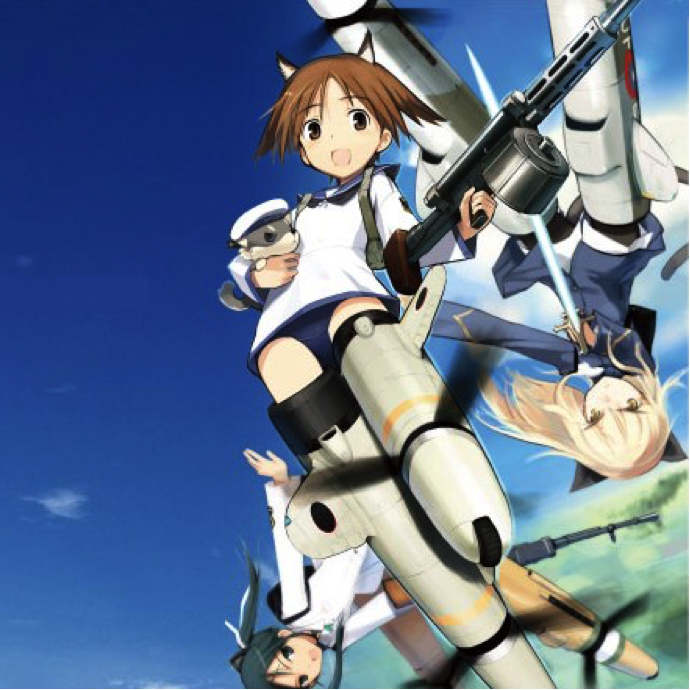shonen women part i: on strike witches and female viewership
As the West and Japan grow more enchanted with each other, our cultural landscape is exposed to new and unique interpretations of the female. This three-part series by Marie Davis explores the characterisation of women in shonen anime and manga, and their relationship with their burgeoning Western audience.
Perhaps the most unique reimagining of the events of World War II is the Japanese anime series Strike Witches. In this alternate tale, Japan fights alongside the rest of Earth against aliens known as Neuroi, with the war’s toughest fighters an assortment of magical witches, all between the ages of twelve and nineteen. The witches fly through the air with the aid of striker units—thick mechanised attachments worn over the legs that must not be encumbered by the bulk of pants. As such, the witches have the choice between wearing either skimpy underpants, or tights so tight-fitting they nestle inside the girls’ vulvas. The series takes the traditional Japanese art of “the panty shot” and turns it into a crucial plot device. The ceaseless assault of teen girl butt on the gaze is not only titillating—it’s necessary to save the world.
I was first introduced to the series by my friend, Jess. A psychologist and a feminist, Jess watched the whole first season for its ridiculousness. For her, watching the series was similar to watching a gory schlock-horror film, in that one expects revulsion, to turn away from the screen with an ‘ugh!’, only to turn back and do it all again.
‘If boys were to watch this show, then that would be illegal,’ she tells me as we watch the episode ‘Nice ‘n Breezy’, in which one of the witches cannot find her panties, starting an intricate web of panty thievery within the military unit.
‘Okay, but everyone who watches this show is probably a boy,’ I say.
‘I’m not a boy,’ she replies. It’s a fair point. Roughly half of my anime-watching friends are women, and we all watch shonen—anime or manga targeted towards males in their teens and older. And with manga magazine Weekly Shonen Jump claiming an audience that’s almost half female, it’s clear that the male-targeted genre has been somewhat eroded by a female audience. But why? The answer is complicated.
Strike Witches is bizarre not only because it turns WWII into a battle between aliens and panty-clad adolescents, but also because it’s a series targeted at males, while comprised entirely of female leads. The character development and plot-lines are all driven by women, something almost unimaginable in a male-targeted Hollywood blockbuster. It’s not that strong female characters don’t exist in Western sci-fi or action genres (Sarah Connor, Furiosa, Kathryn Janeway, Ripley, and Dana Scully, just to name a few) but female characters in Western media still seem like a novelty, and the expectation that women will be portrayed in the cinema as visibly as they are in real life is very seldom met.
For example, when the first cast list of Star Wars Episode VII was released in April 2014, there was only one new female lead to join Princess Leia in the Star Wars universe, and many women were not happy. In responding to this cast list, Annalee Newitz of io9 wrote:
‘So when Star Wars cannot offer us anything remotely like a diverse cast of characters, at a time in history when we know better […] It’s a move that will absolutely shape how children think about themselves, and the possibilities that are open to them. It’s a decision that sends a signal to adults about where they stand relative to each other.’
A year earlier, the cast of Pacific Rim was criticised by Kyle Buchanan in Vulture for its lack of female roles, despite lead female pilot Mako Mori (portrayed by Rinko Kikuchi). For him, Pacific Rim ‘seemed to inherently promise the sort of gender equality you don’t always get from a giant action movie’, but he was inevitably put off by Mori’s lack of lines, as well as the limited presence of other female characters: ‘Even in the crowd scenes, male extras appear to outnumber women five to one!’
There is the argument that women aren’t prominent in male-targeted genres because that particular media is for men, and thus needs relatable male protagonists, but this argument doesn’t hold much water. For me, and others who were teenage girls during the early ’00s, the shows targeted at us were soaps like Dawson’s Creek, One Tree Hill, and The O.C., and all were viewed through the lens of a male protagonist. Routinely, women are expected to view the world through the eyes of men, to relate to men, while the inverse is seldom accepted.
For many female fans of action and sci-fi, shonen is the logical conclusion. Women are commonplace, often put in positions of power, and are explored to depths rarely seen in popular Western media outside of a Joss Whedon series. But there is a price for the exposure of women in shonen, and that price is often over-sexualisation of female leads.
Any time we consume media, we are forced to make sacrifices, and women who consume shonen media are not oblivious to this. But our options are limited. Rather than be seen as feminazis for our critiques, we are tempted to shrug it off when a fourteen-year-old’s butt is shoved in our faces. We laugh, we cringe, and we make jokes, but there is always discomfort in the pit of our stomachs. We are perceived as smarter, stronger, and more capable than we ever have been, but even in our cartoon form, we still pay the price for our presence with our bodies.



Feminism, anime, thoughtful discourse, butts. THIS ARTICLE’S GOT EVERYTHING.
Brilliant! Well written! I can’t wait to read the next two parts.
Pingback: shonen women part ii: on haruhi suzumiya and moe obsession | lip magazine